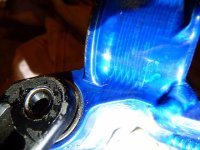Dingo2024
100 W
Hi, just came across this article;
http://www.pinkbike.com/news/To-the-Point-Heat-Treating-Aluminum-Frames.html
Ian
http://www.pinkbike.com/news/To-the-Point-Heat-Treating-Aluminum-Frames.html
Ian
Dlogic said:Excellent article. Thank you. That´s why i´ll stick to steel when building my frames. It´s heavier but more forgiving and easier to handle.
Farfle said:Absolutely, steel is the ideal metal for homebrew frame building. And its not heavier when done right, but doing it right requires a lot of small ladder frames and thin wall tube that's a bitch to weld.

Never mind that the article was written by Richard Cunningham :lol:full-throttle said:Jeff Steber can talk all he wants about "heat treating in house" and "made in USA", but he will never convince me to buy Intense again
I'm a bit slow today - what's the connection? :?Hyena said:Never mind that the article was written by Richard Cunningham :lol:

speedmd said:I have been working with both 6061 and 7005 tubes the last 15 years and can tell you that properly tempered 7005 is way stronger, harder and resilient than the 6061 in any temper. IMO it is Not even close.
speedmd said:The specs are not close at all. Ultimates are some 25% stonger and the fatigue strength some 80% higher on the 005. Don't be fooled by the closeness of some of the less meaningful tensile numbers. They use it because it is way better. Raw material / tubes are much more expensive / harder to make in the 005. Thin walled bike tubes even harder. Much better when done however.
Neither of these alloys has an endurance limit stress in fatigue. What do you mean by fatigue limit?speedmd said:Hi Chalo
Good topic. Agree, best to get the design correct and forget the fancy stuff until you work out the hot/ weak spots. Good material does not compensate for poor design.
I have test data putting 7005 t53 at over 390mpa consistently. Hard pressed to find anything in the 6061 family to get to 300mpa and that if all goes well. Yield of over 340 vs max of 275mpa, Fatigue limits of 150 vs best of 96 mpa for the 6061.
Good point on the variation in tempers in the supply chain. Agree, this is significant and can swing results quite a ways to the negative and I believe more so in the 6000 alloys.
If you were to play with something like a long x country ski poles made with each, I believe you would quickly see what I mean.
7005 will be cheaper if thats all the supplier is running as many running bike tubes are. 20000-40000 pound minimums make it hard to run too many types and no extravagant time. In the US the 7000 series alloys are much more money and most extruders will not deal with them as they push slow.
I would not believe anything on a w-mart bike sticker. Not anything.
Neither of these alloys has an endurance limit stress in fatigue. What do you mean by fatigue limit?
speedmd said:Neither of these alloys has an endurance limit stress in fatigue. What do you mean by fatigue limit?
YES. The terms Fatigue limit, endurance limit, and fatigue strength are all used in many circles to describe roughly the same thing. Wiki has more on the terms and exact meanings. http://en.wikipedia.org/wiki/Fatigue_limit
Aluminums as most have seen, have a significantly shorter life than steel when flexed repeatedly. This coupled with it's more sudden failure mode makes this something to pay attention to when making a flexible frame such as a bike. Having had frames completely fail under me, it is something you do not wish to happen. Very different SN curves than steel.
